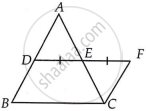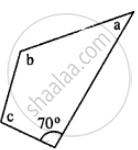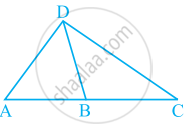Advertisements
Advertisements
प्रश्न
D and E are the mid-points of the sides AB and AC respectively of ∆ABC. DE is produced to F. To prove that CF is equal and parallel to DA, we need an additional information which is ______.
पर्याय
∠DAE = ∠EFC
AE = EF
DE = EF
∠ADE = ∠ECF
उत्तर
D and E are the mid-points of the sides AB and AC respectively of ∆ABC. DE is produced to F. To prove that CF is equal and parallel to DA, we need an additional information which is DE = EF.
Explanation:
We have produced DE to F such that
DE = EF ...(1)

In ΔADE and ΔCFE,
AE = CE ...[Since, E is the mid-point of AC]
∠AED = ∠CEF ...[Vertically opposite angles]
DE = FE ...[By (1)]
∴ ΔADE ≅ ΔCFE ...[By SAS congruency]
∴ AD = CF and ∠ADE = ∠CFE ...[By C.P.C.T.]
This shows that alternate interior angles are equal.
Thus, AD || CF
Therefore, the additional information which we need is DE = EF
APPEARS IN
संबंधित प्रश्न
Two angles of a quadrilateral are of measure 65° and the other two angles are equal. What is the measure of each of these two angles?
Determine the number of sides of a polygon whose exterior and interior angles are in the ratio 1 : 5.
Complete the following statement by means of one of those given in brackets against each:
If both pairs of opposite sides of a quadrilateral are equal, then it is necessarily a ...............
In the given figure : ∠b = 2a + 15 and ∠c = 3a + 5; find the values of b and c.

In a quadrilateral ABCD, AO and BO are bisectors of angle A and angle B respectively. Show that:
∠AOB = (∠C + ∠D)
In parallelogram ABCD, its diagonals intersect at point O. If OA = 6 cm and OB = 7.5 cm, find the length of AC and BD.

What is the maximum number of obtuse angles that a quadrilateral can have?
The number of obtuse angles in figure is ______.
What conclusion can be drawn from part of given figure, if DB is the bisector of ∠ADC?
Draw a rough sketch of a quadrilateral KLMN. State two pairs of opposite angles.
